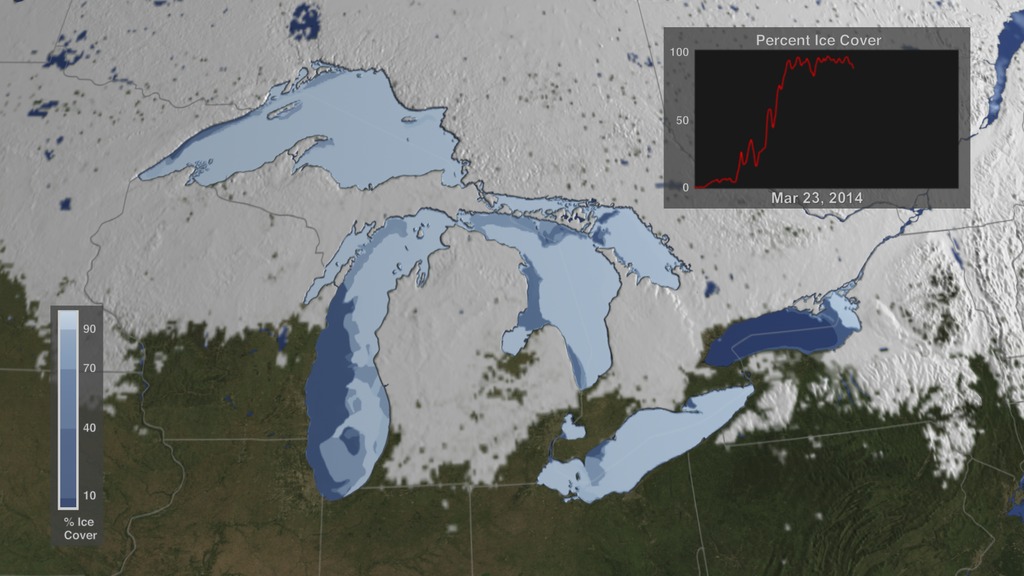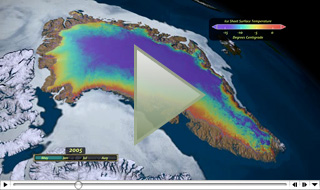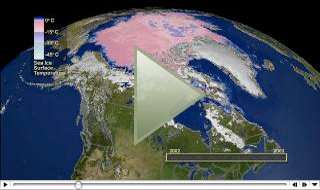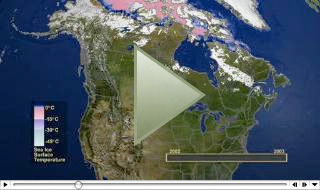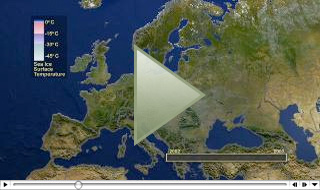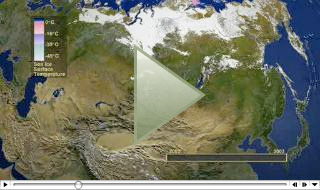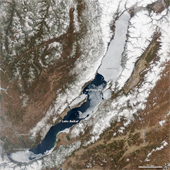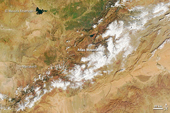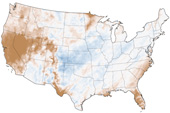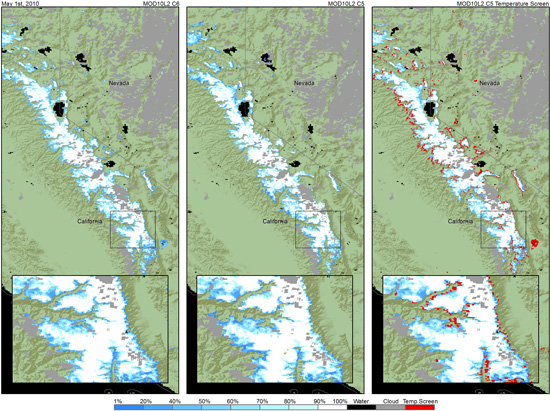
Collection 6
The Collection 6 (C6) suite of MODIS Terra and Aqua snow and ice products contains the products as shown in Table 1. The products are produced both as Terra and Aqua products so the total number of products is 24. Additional products will be become available. The C6 products are much more flexible than the C5 products. Key improvements in the snow algorithms are the use of the full NDSI map so that users may create their own regional snow maps, and the ability to remove the cloud mask. There are also more bit flags with QA information.
Table 1. MODIS Collection 6 suite of cryosphere data products for Terra and Aqua.| Earth Science Data Type (ESDT) | Product Level | Spatial Resolution | Temporal Resolution | Data Arrays |
|---|---|---|---|---|
| M*D10_L2 | L2 | 500 m | 5 min swath | Snow Cover |
| M*D10A1 | L3 | 500 m | daily | Snow Cover, Snow Albedo |
| M*D10C1 | L3 | 0.05° x 0.05° | daily | Snow Cover |
| M*D10A2 | 500 m | 8-day | Snow Cover | |
| M*D10C2 | L3 | 0.05° x 0.05° | 8-day | Snow Cover |
| M*D10CM | L3 | 0.05° x 0.05° | monthly | Snow Cover |
| M*D29 | L2 | 1 km | 5 min swath | Sea Ice Extent, Ice Surface Temperature |
| M*D29PGD | L3 | 1 km | day | Sea Ice Extent, Ice Surface Temperature |
| M*D29PGN | L3 | 1 km | night | Ice Surface Temperature |
| M*D29P1D | L3 | 1 km | day | Sea Ice Extent, Ice Surface Temperature |
| M*D29P1N | L3 | 1 km | night | Ice Surface Temperature |
| M*D29E1D | L3 | 4 km | day | Sea Ice Extent, Ice Surface Temperature |
MODIS Snow Cover Algorithm
Changes for Collection 6
Surface Temperature Screen Abandoned
The MODIS fractional snow cover (FSC) algorithm for Collection 6 (C6) is the same as in Collection 5 (C5), however the screens applied to alleviate snow detection errors of commission and omission have been changed. The surface temperature screen for snow commission errors has been deleted from the algorithm in C6 because it was discovered that the screen has a detrimental impact on mapping snow cover on mountains in the spring and summer. The impact of the surface temperature screen on mountain snow cover is exhibited in this time series comparison of C6 to C5 FSC (Fig. 1).
The purpose of the surface temperature screen was to alleviate false snow detection on warm bright surfaces, which it did, however; it also had a detrimental impact on detection of snow cover on mountain ranges in spring and summer. As surface temperatures warmed in the spring and snow ablated, the surface temperature of pixels having some fraction of snow cover increased to above the fixed surface temperature screen threshold of 283 K. When that happened, a pixel with FSC was reversed to a "no snow" result in the algorithm. The detrimental effect was that snow cover 'disappeared' before ablation was complete. Though the total area of FSC that was reversed to "no snow" by the surface temperature screen was relatively constant over time (Fig. 1) the proportion of total snow present that was reversed by the temperature screen increased through June to nearly 100% of summer time mountain snow cover (Fig. 2).
Fractional snow cover from the MODIS swath level snow product MOD10_L2 from C5 and C6 is compared in this time series, 1 May 2010 to 1August 2010, of MOD10_L2 FSC maps covering the Sierra Nevada mountain range (Fig. 1). In C5 the FSC algorithm was applied to every pixel then a surface temperature screen was applied to every pixel having FSC and if the surface temperature was greater than the screen threshold then the FSC result was reversed to a result of no FSC, i.e. FSC=0.
 Figure 1. Amount of FSC area mapped as snow (blue bars) and amount of FSC area reversed to FSC = 0 (red bars) in the MOD10_L2 C5 algorithm, daily over the period 1 May to 1 August 2010. The amount of FSC reversed through the season averaged about 1208 km^2 per day, 1 May – 1 August. Days with cloud cover > 20% were omitted from this graph so that the seasonal trend in FSC can be seen.
Figure 1. Amount of FSC area mapped as snow (blue bars) and amount of FSC area reversed to FSC = 0 (red bars) in the MOD10_L2 C5 algorithm, daily over the period 1 May to 1 August 2010. The amount of FSC reversed through the season averaged about 1208 km^2 per day, 1 May – 1 August. Days with cloud cover > 20% were omitted from this graph so that the seasonal trend in FSC can be seen.
 Figure 2. Daily determination of the amount of FSC that was reversed to "no snow" by the surface temperature screen in MOD10_L2 C5. The FSC (blue bar) and the FSC reversed to no snow (red bar) sum to 100% each day. The proportion of FSC reversed began to increase significantly about the first of June, reaching about 90% around the first of July, corresponding to increasing summer temperatures.
Figure 2. Daily determination of the amount of FSC that was reversed to "no snow" by the surface temperature screen in MOD10_L2 C5. The FSC (blue bar) and the FSC reversed to no snow (red bar) sum to 100% each day. The proportion of FSC reversed began to increase significantly about the first of June, reaching about 90% around the first of July, corresponding to increasing summer temperatures.
Time Series of FSC maps of Sierra Nevada 1 May to 1 August 2010.
The FSC from C6 (left image) and from C5 (center image) is shown in shades of blue to white with other features in other colors. FSC pixels reversed to "no snow" in C5 by the surface temperature screen are shown in red in the right image. Reversal of FSC occurred at the edges of snow cover and made proportionally more of the snow 'disappear' as the snow line retreated during spring and summer. The inset image gives a higher image resolution of the effect at the snow line.
Abandoning the surface temperature screen will result in some surface features that have reflectance features similar to snow being detected as snow covered through-out a year. In this series of images the mineral surfaces near the Naval Air Weapons Station, China Lake, CA, located just east of the southeast corner of the inset box, are detected as FSC in C6, the circular area of low FSC in the MOD10_L2 C6 FSC image without the surface temperature screen. In MOD10_L2 C5 that feature was prevented from being mapped as snow cover by the surface temperature screen which reversed the FSC detection the corresponding red circular area in MOD10_L2 C5 temperature screen image. During the winter when mineral surfaces were cold and snow free the surface temperature screen was ineffective at preventing snow commission errors on them. Surface features of this nature are invariant and fixed in location so can be masked from analysis over a regional area. A global map of surface features to exclude from snow mapping algorithm can be compiled and applied to the MODIS snow products.
Collection 6 processing and reprocessing is scheduled to begin in 2012.

